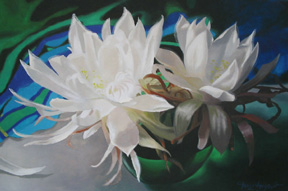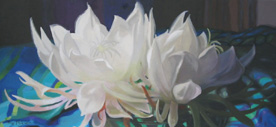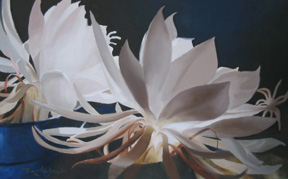Franz Heigemeir
at the Woodstock Artists Association
By
RAYMOND J. STEINER
ART
TIMES July, 2005
|
|
EVERY SO OFTEN we are treated to an artist’s vision that can well nigh overpower us with its haunting beauty — a particular case in point, Franz Heigemeir’s “Night Blossoms” currently on view at the Woodstock Artists Association.* “Night Blossoms”, Heigemeir’s “celebration of a rare event” — specifically the blooming of a cactus (epiphyllum oxypetalum, “Queen of the Night”) that he and his wife have nurtured over the years — is comprised of fourteen paintings ranging in size from a modest 18”x24” to a diptych some nine feet wide by three feet high. As the exhibit’s title indicates, the paintings are floral depictions of a plant that only blooms at night (indicated by the simple black background that fills most of the paintings), its delicate blossoms an astonishingly joyous challenge of light to the night’s all-encompassing darkness. What Heigemeir has captured in his paintings is the power of these delicate blooms to not only generate their own glow, but also to mysteriously imbue the surrounding night with a luminosity that — for want of a better word — can only be called ‘magical’. Rendered larger than life — the sheer dimensions of the larger paintings dramatically adding to their already overwhelmingly exquisite presence.
|
|
Heigemeir’s “Night Blooms” seduce the eye — more, draw the viewer into a place of soft radiance, sort edges, soft dreamlike images, that seem to offer a tropical Eden of untold wonder and mystery. The raw sexuality often found in Georgia O’Keeffe’s similarly wrought close-ups of flowers is here tempered by a gentler vision, a more spiritual sensibility. In spite of their dramatic impact on our visual sense, Heigemeir’s blooms do not shock — nor are they intended to. They beguile rather than assault the eye. Their subtle colors — ivory, pinks, blues, earth tones — suggest delicate fragrances, not, as do O’Keeffe’s, the elemental musky odor of sex. Still, Heigemeir’s night blooms entice, they beckon more than a casual glance, they invite propinquity, close inspection, even intimate touch. In this respect — in their power to draw us in — their allure almost suggests something sinister, something like the deadly attraction of the Venus flytrap — but this I only felt in retrospect, back in my study when I re-thought my immediate impressions which arose while standing in front of them.
|
|
That
the exhibition of Heigemeir’s paintings can evoke such contradictory
conclusions says more perhaps about me than it does the artist.Yet,
that this contradiction exists — again at least for me — speaks
to a power in the painter’s art that goes far beyond the usual fare
one finds in today’s art galleries. When a painter makes us not
only see, not only feel, but also think, we have more than the occurrence of a night
bloom — or an artist’s ability to capture the event —
to cause celebration. “Night Blossoms” is no mere showing
of precise botanical rendition, no clever display of painterly virtuosity.
This is art at its most powerful best — art that startles, enlightens,
that gently but firmly nudges us off our habitual center of gravity and
broadens our view of the world. No less than his night blooms, Heigemier’s
artistic vision can also be celebrated as a rare event — one that
deserves to be shared with a much wider public.
*“Franz Heigemeir: Night Blossoms: A Painter’s Celebration of a Rare Event” (thru Jul 3): Woodstock Artists Assn., 28 Tinker St., Woodstock, NY (845) 679-2940.



